I was at home with a friend who was visiting with her 12 year old son. He wanted to visit Mobeens, a local take away renowned for, amongst other things, their kebab rolls. It’s about 12 minutes walk from my house or a 5 minute bike ride or scoot and he wanted to borrow our adult scooter. So I suggested that my friend borrow my bike to keep up. She said she hates cycling to places because she doesn’t like locking up her bike outside. Cycling around for a leisurely ride? No problem. Cycling on road? She is fine with that. Cycling to the shops, and leaving your bike outside? No quite ready for that yet.
Don’t worry, I said, here’s a lock, it’ll be fine. She wasn’t convinced. But, she said, if you write a piece about how to lock your bike, then I might do it next time..
So, here you go.
Kryptonite, the maker of locks named after the substance that weakened Superman has some great advice on this topic. They must figure they make locks so strong that even Superman can’t break into them. They actually use the name Kryptonite under a licence agreement with DC Comics that dates back to 1983. Kryptonite have a really helpful video in which I learned two invaluable principles to locking up your bike.
1. Lock up your bike in order of value. So, main frame first, then back wheel then front wheel. What this means is if you can only lock one part of the bike for whatever reason, lock the main frame. If you can fit another part of your bike on, choose the back wheel as well. Then add in the front wheel if you can, with with an additional lock or cable. Basically this rule of thumb is based on the fact that if a thief can’t take your whole bike, they may still try to take a part of it. Here is what this might look like, here I have locked up the main frame and back wheel.

In this video, my friend has locked up all three main parts of the bike using two locks.
[VIDEO TO FOLLOW, WORDPRESS SETTINGS DON’T ALLOW ME TO ADD VIDEOS YET!]
2. Get as much bike into the lock as you can. This means don’t leave the lock able to move too much. If it is less movable, bike thieves will find it harder to move a bit of the lock away from the bike to break it. Here is what this might look like.
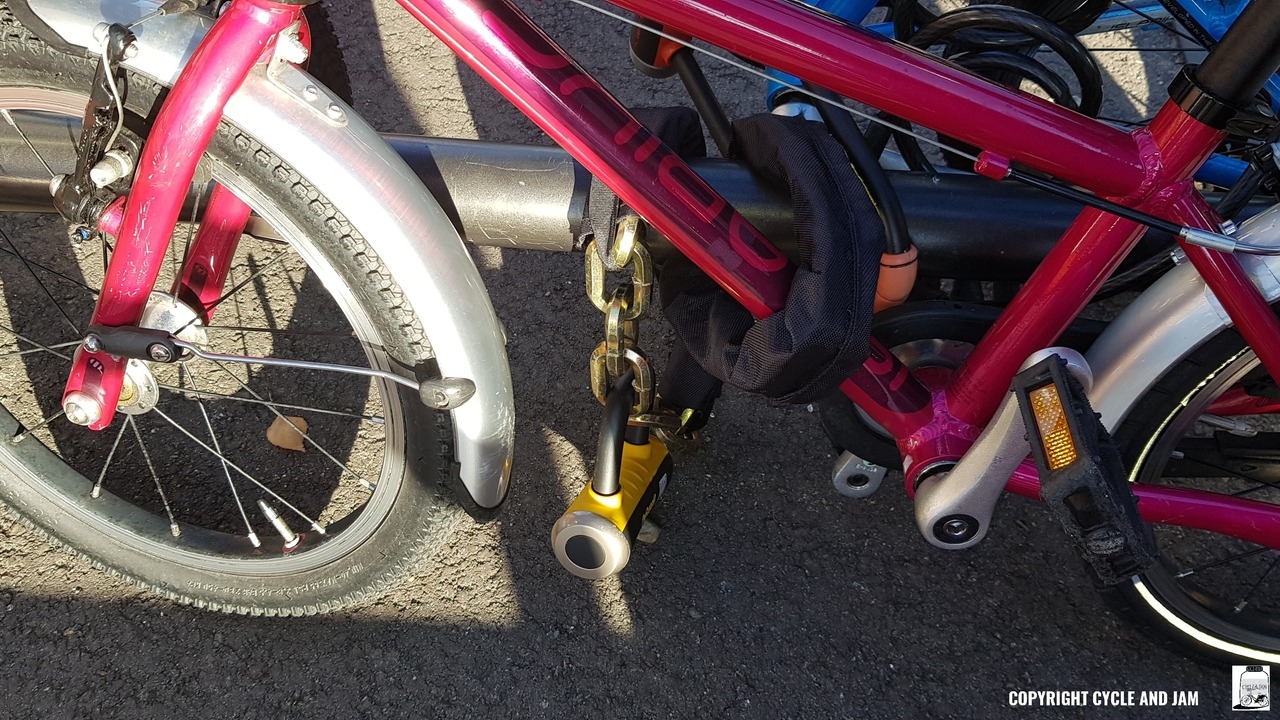
Here I’ve wound the long chain lock around the bike and bike rack twice to reduce the amount of movement of the lock, so a thief can’t pull a chunk of the lock away to break it. The chain lock doesn’t fit into the spokes of my daughter’s small 16in bike so I’ve locked the main frame up as the most valuable part.
Generally a D lock (also known as a U lock in some countries) is recommended over a cable lock. However I really like a decent chain lock as I find it easier to lock up the bike without having to get the angle and position of the bike against the bike stand just right. Having said this, I use mostly D locks as I just can’t justify buying a whole load of new locks to replace our perfectly usable D locks. We have about 4 D locks in the family, as we have 4 bikes and a trailer. So I’m not going out to replace them all, but my personal preference if I was buying again would be to only get chain locks.
Think about whether you want a combination lock or one with keys. If you lose your key you’re a bit stuck. You can register your lock with the big brands so that they send you a replacement if you lost it, but it’s clearly a bit of hassle. However my chain locks both need keys so I have had to just get used to bringing it along with me.
Make sure you are locking up an enclosed part of the frame. So don’t choose to lock up you bike with the seat post for example. You can remove a seat post very easily, and so that’s an open ticket to a bike thief. You can choose the top cross bar of the bike, or the triangular part of the frame that holds the back wheels (there must be a technical term for this but I don’t know it!).
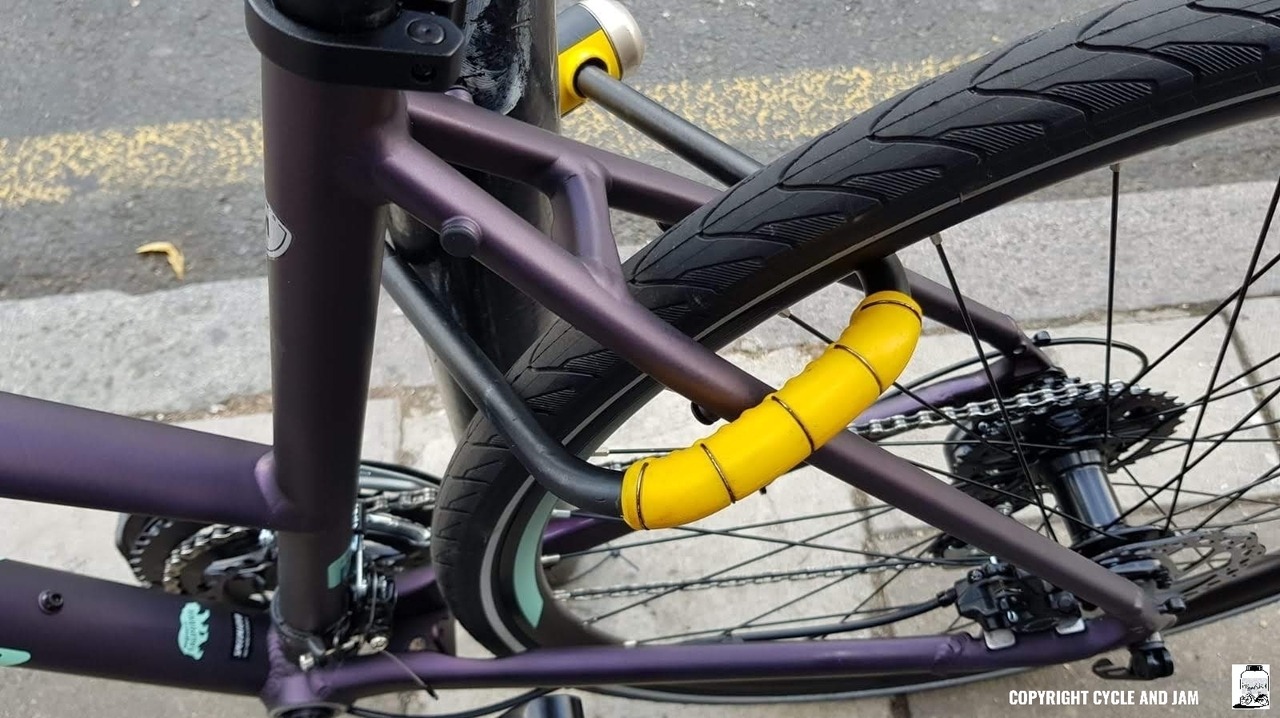
Don’t use a thin cable lock. They are so easily cut into, you may as well leave the bike unlocked. Well maybe not, but it’s not too far off doing that. When setting a budget for buying a bike, include in that an allowance for a decent lock. I heard Dublin Cycling Campaign say you should spend about 10% of the value of your bike on the lock. Which sounds like sensible advice as there really is no point spending a hundred quid or more on a bike and then locking it up with a flimsy lock.
If you have quick release wheels, then try to take the front wheel with you. It’s so easy to remove so it’s easy to steal, and has value in itself even if a thief can’t take your whole bike. If the front wheel is missing the bike as a whole is less attractive to a bike thief as they are looking for a quick sell.
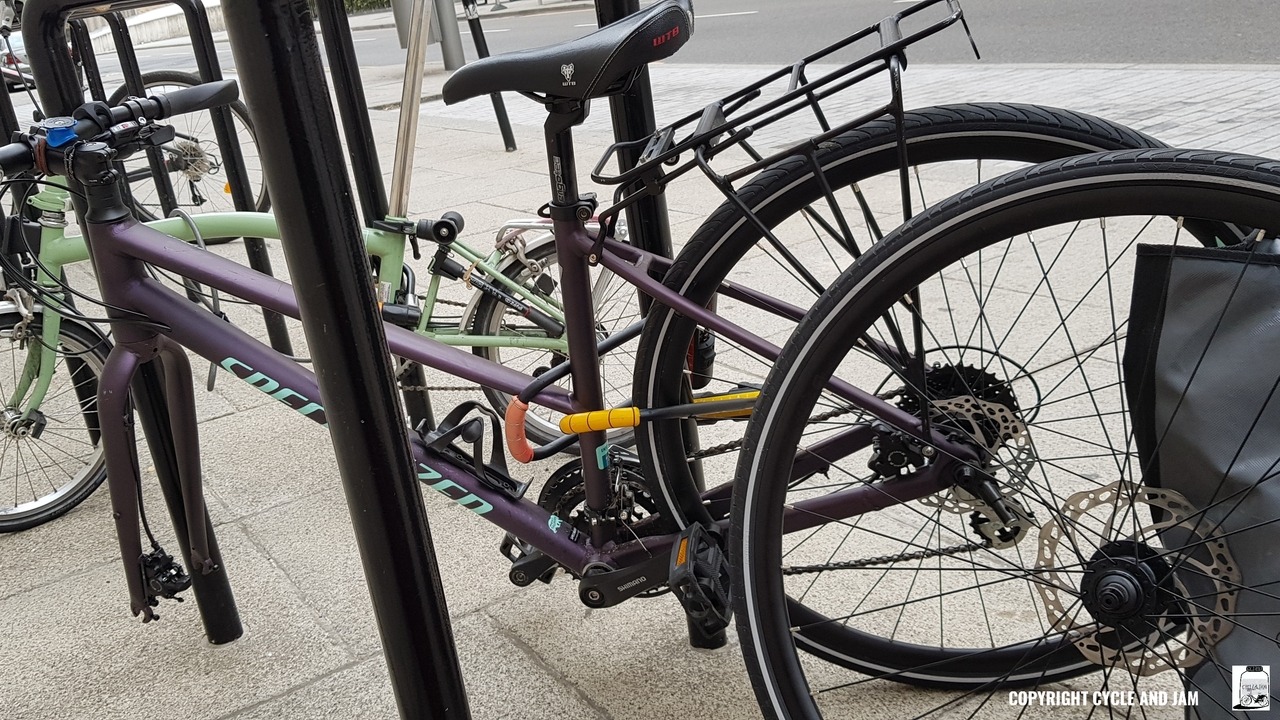
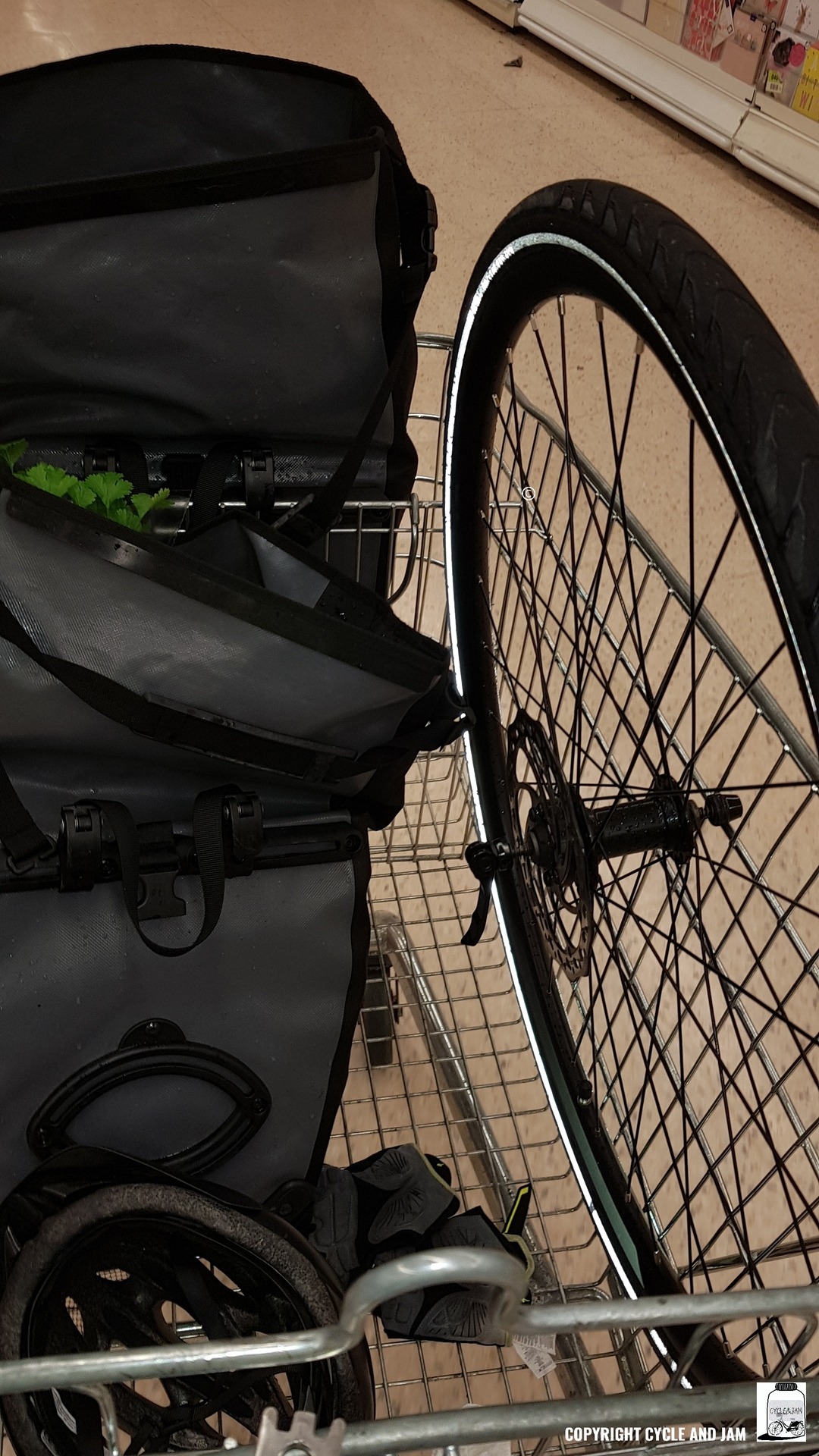
This last pic is me on a shopping trip to the supermarket, with my front wheel in the trolley. Which makes for some interesting conversations as you walk around, which is all good as it gets people talking about cycling!
If you are locking up more than one bike and there is only one space on the bike racks, you can try to lock one of your bikes to the rack and the other bike to your bike.
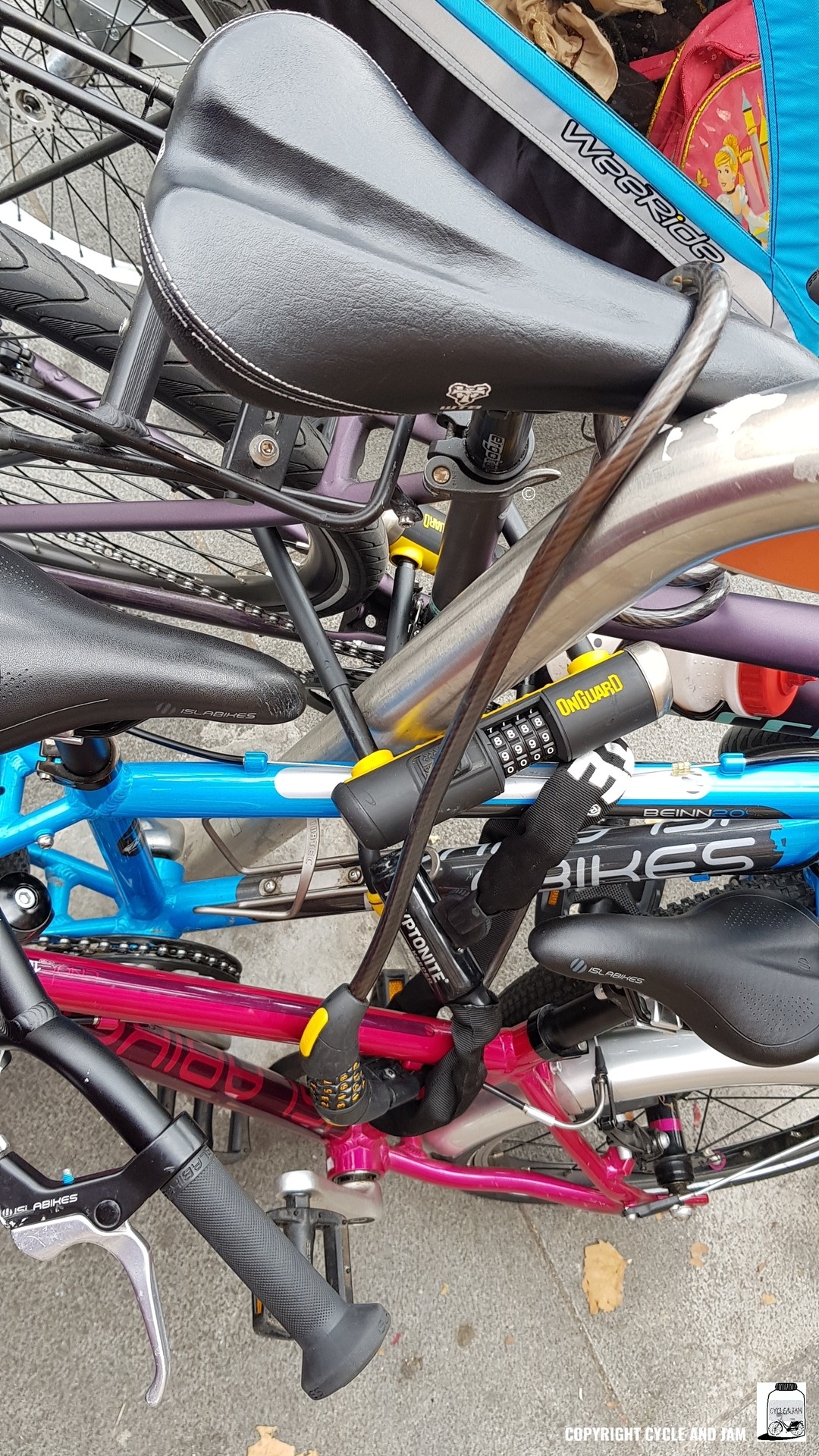
Use two locks if you can, for added security. Even better is if these two locks are two different types. Thieves then needs to have two different tools with them to cut into your bike, which they are less likely to have. An example of this is in the pic below, and also the video above.

Sadly bike theft is on the rise and their methods are getting more sophisticated, for example with the use of sprays to weaken locks before cutting into them. The key to locking up your bike, if you can pardon the pun, is to provide a deterrent to the would-be thief. You won’t be able to stop them just with your lock, as nothing is unbreakable. But you can lock your bike in such a way that the moveable parts such as wheels are harder to get to, and so that stealing your bike seems like too much hassle for the chancer passing by wanting a quick buck.
Lock your bike in a place that is well lit, visible and busy, and ideally with CCTV. Choose a large bike rack if possible rather than the smaller ones that only allow you to lock a wheel into them. Or you can choose something that is a immovable such as a lamppost or railings, if you have permission to do so with the latter. I don’t like the Plant Lock racks that have sprung up in some places, as the guy from the cycling department in the council warned me that these deteriorate over time, so much so that the U frame that you lock your bike onto can can be easily pulled out in older ones. I saw one recently and tried this- I was genuinely shocked at how easily I could just lift the U frame out. If I can go back I will get a picture of it and update this post!
If you are unfortunate enough to have your bike stolen, try looking in Bikeshd, they bring together all bikes for sale second hand online in one place.
And you can always try putting out a message to the bike thief, you may just scare them enough to return it, as this lady did!
You can also register your bike with the national Bike Register (I haven’t got round to doing this yet but have been told it’s an easy process).
You should keep a record of your bike frame number (found on the bottom of the bike frame, near the seat post), make, model and colour. Keep a photo of yourself with your bike. This will allow you to prove the bike belongs to you should it be stolen and then recovered.

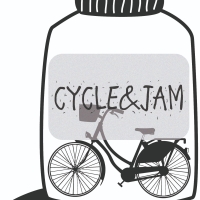
Great advice. You can also register your bike with ‘Immobilise’ as the Police told me, when my bike was stolen.
LikeLike